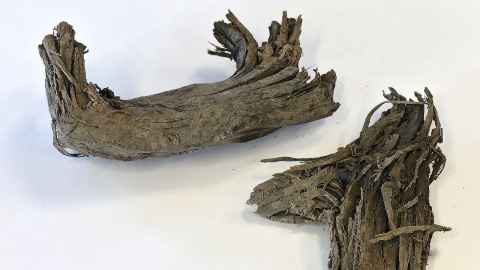University scientists date ancient tree at 28,000 years
8 April 2020
Radiocarbon dating has estimated that fragments of a tree recovered from a City Rail Link construction site are 28,000 years old – a time when moa, woolly mammoths and sabre tooth tigers still roamed the planet.

The age of the fragments was confirmed after radiocarbon analysis by scientists and researchers at DEVORA (DEtermining VOlcanic Risk in Auckland) co-led by the University of Auckland and GNS Science.
Fragments of the tree, probably a whau, were recovered under an ancient lava field 15 metres below ground while CRL’s small tunnel boring machine was excavating a new stormwater drain at Mt Eden in February 2019.
“This tree is an exciting find for volcanologists because it confirms that Maungawhau/Mt Eden erupted about 28,000 years ago,” says DEVORA volcanologist Elaine Smid, who is based at the University.
“We have used other techniques to date this eruption, with similar findings. This new radiocarbon result removes any lingering doubts about the age of Maungawhau/Mt Eden.”
Auckland 28,000 years ago was a very different place. It was untouched by humans, wildlife consisted mainly of birds, including the long-extinct moa and the beautifully coloured huia, and the land was covered by hardwood forest and shrubs. Prominent volcanic landmarks like Rangitoto, Motukorea/Browns Island, Maungarei/Mt Wellington and the Panmure Basin did not exist. Beyond Auckland, Ngāuruhoe in the central North Island did not exist either.
The Earth was in the throes of an Ice Age – temperatures were colder, sea levels were lower, and woolly mammoths and sabre-tooth tigers still survived.
The tree’s discovery was made during critical works for CRL – excavation of the new stormwater drain was necessary for the project’s tunnels to connect with Auckland’s existing rail network at Mt Eden.
“It’s fantastic that a project focused firmly on Auckland’s future growth as an international city has been able to unlock a scientific treasure from a very distant past and help us learn more about the place so many New Zealanders call home,” says City Rail Link Ltd Chief Executive, Dr Sean Sweeney.
Iwi involved with CRL describe the discovery as an enlightening one, connecting two significant events: the eruption and creation of Maungawhau and the construction of the nearby City Rail Link.
“Both events in their own way are creating dramatic changes to the landscape of Tāmaki Makaurau and the way we interact with it for generations to come,” says Gabriel Kirkwood, Kaitiaki for Ngāi Tai ki Tāmaki – Taiaomaurikura. “The research undertaken into the age of the tree provides a valuable insight into the history of Tāmaki Makaurau and the scientific contribution to this knowledge will not be forgotten.”
While the age of the tree is confirmed, scientists are unsure of its fate at the time Maungawhau/Mt Eden erupted.
Shock waves from the eruption may have knocked over the tree, or it may have already fallen a short time before the eruption into a pond or swamp where it was protected from being burnt by spreading lava.
“The wood was nicely preserved. It doesn’t seem to have burned up and turned to charcoal, which we would expect if the tree was knocked over by the lava flow. Either way, the radiocarbon date for the wood gives us a really good idea of when Maungawhau/Mt Eden erupted,” Ms Smid says.
Even today, 28,000 years on, the tree fragments recovered from the CRL site still have a scientific role.
“DEVORA scientists use volcano ages to identify eruption patterns to better understand how the Auckland Volcanic Field has behaved in the past – it’d like a big puzzle,” says Ms Smid. “This age is another piece in that puzzle. Every piece we add tells us a little more about how the volcanic field may behave in the future, making Auckland a safer place.”
DEtermining VOlcanic Risk in Auckland (DEVORA) is a transdisciplinary, multi-agency, collaborative research programme aimed at improving assessment of volcanic hazard and risk in the Auckland metropolitan area. It is co-led by the University of Auckland and GNS Science and supported by the Earthquake Commission and Auckland Council.
Media contact
Anne Beston | Media adviser
DDI: 09 923 3258
Mob: 021 970 089
Email a.beston@auckland.ac.nz